Abstract
Resistance to infection with Toxoplasma gondii and Listeria monocytogenes in BALB/c female mice decreased with increasing age. The decrease was apparent as early as 9 months of age and was more marked as the animals aged further. This age-related decline in resistance was not restricted to BALB/c female mice, as male and female mice of the C57BL/6 strain exhibited similar responses. With both pathogens, aged mice showed a more marked susceptibility to the strain of lesser virulence. Transfer of normal serum from old mice to young or old mice before infection with T. gondii resulted in an increased susceptibility to this organism, suggesting the presence of inhibitory factors or the absence of potentiating factors that are present in the serum of young mice.
Full text
PDF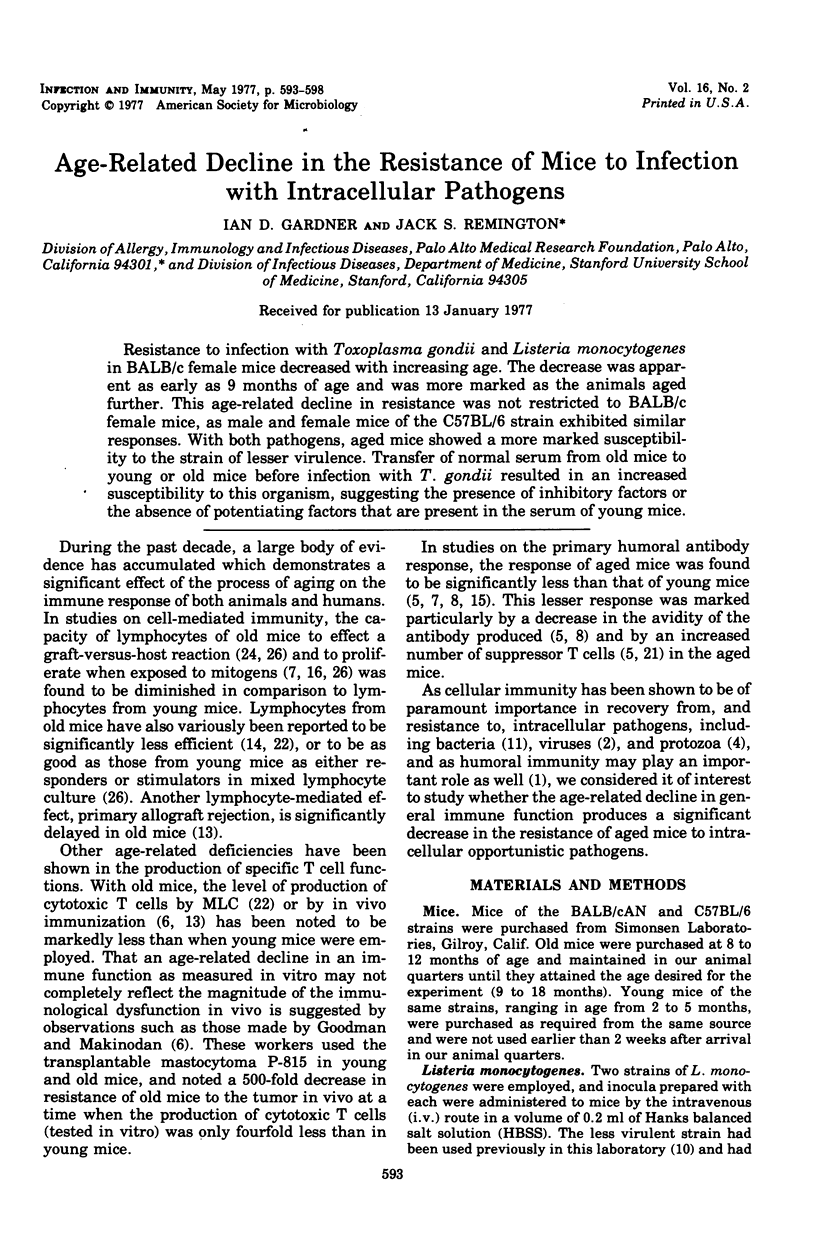
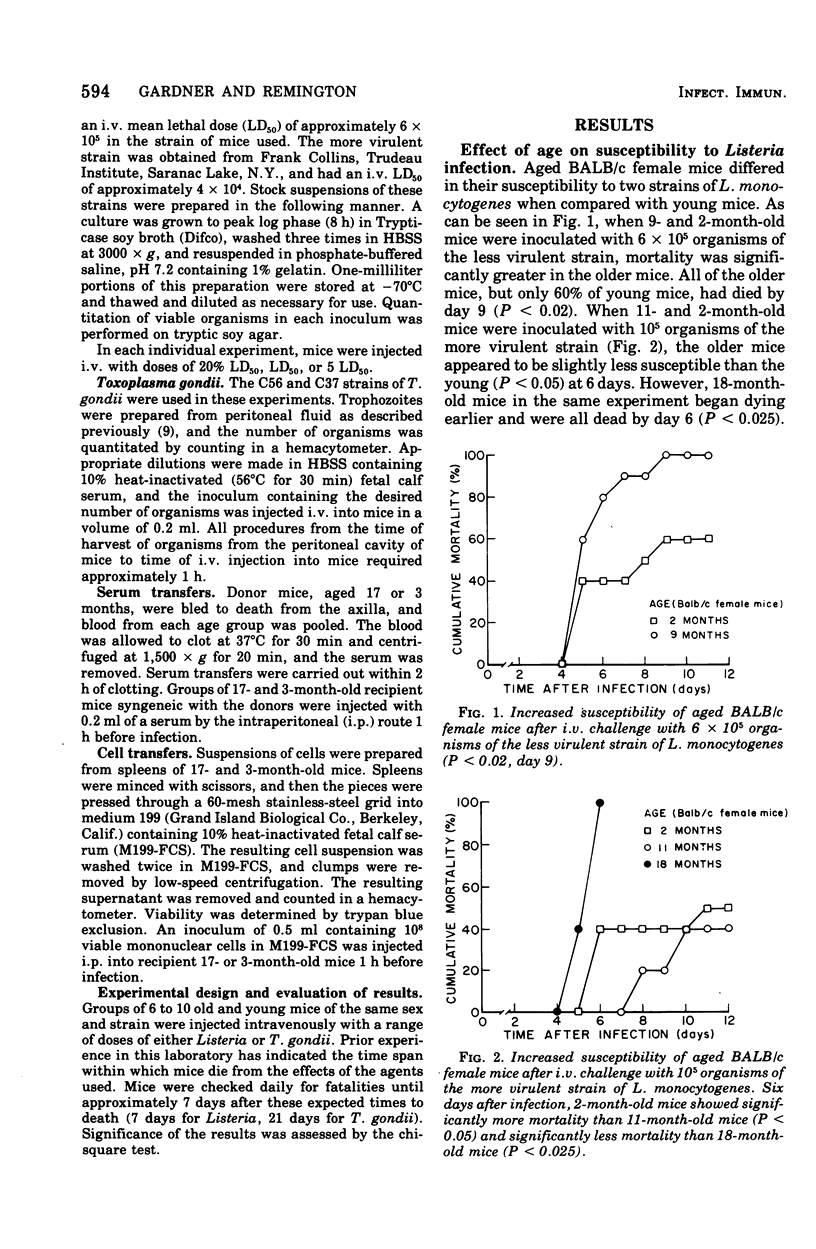
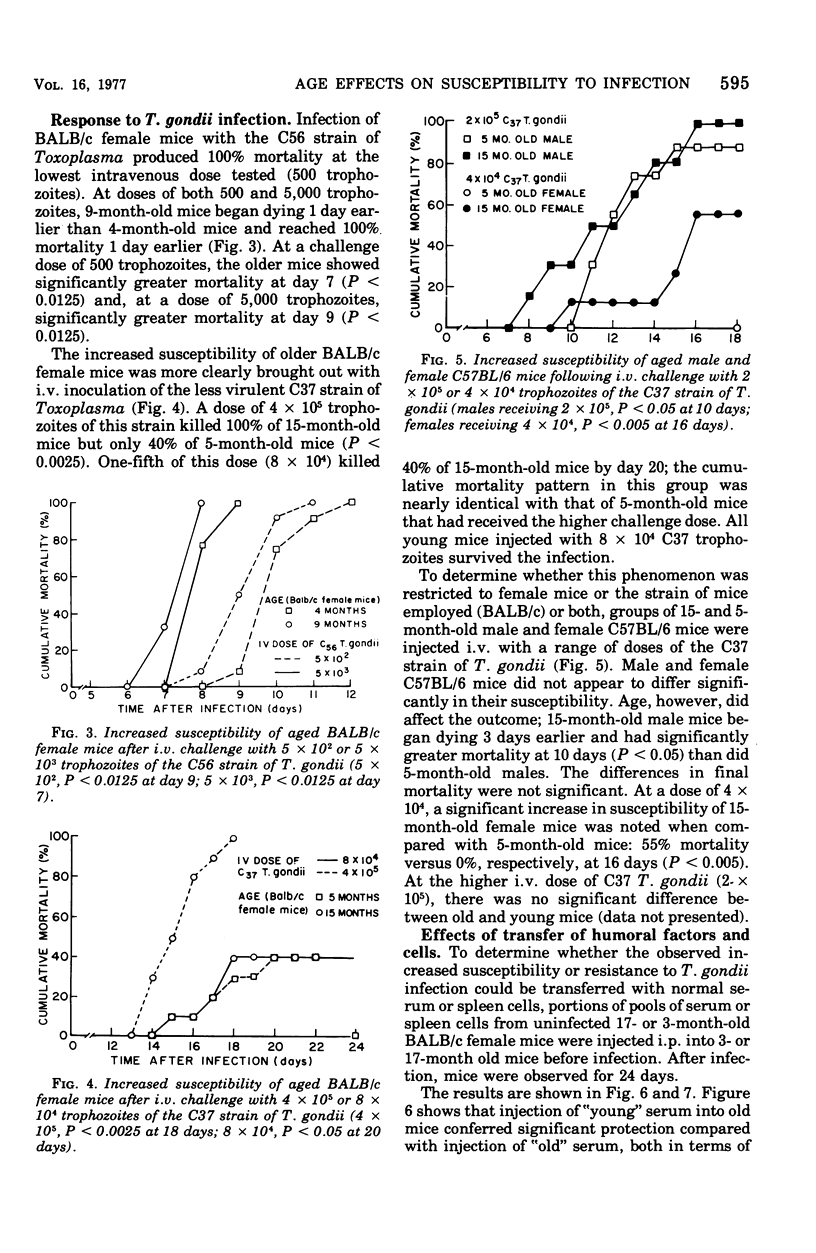
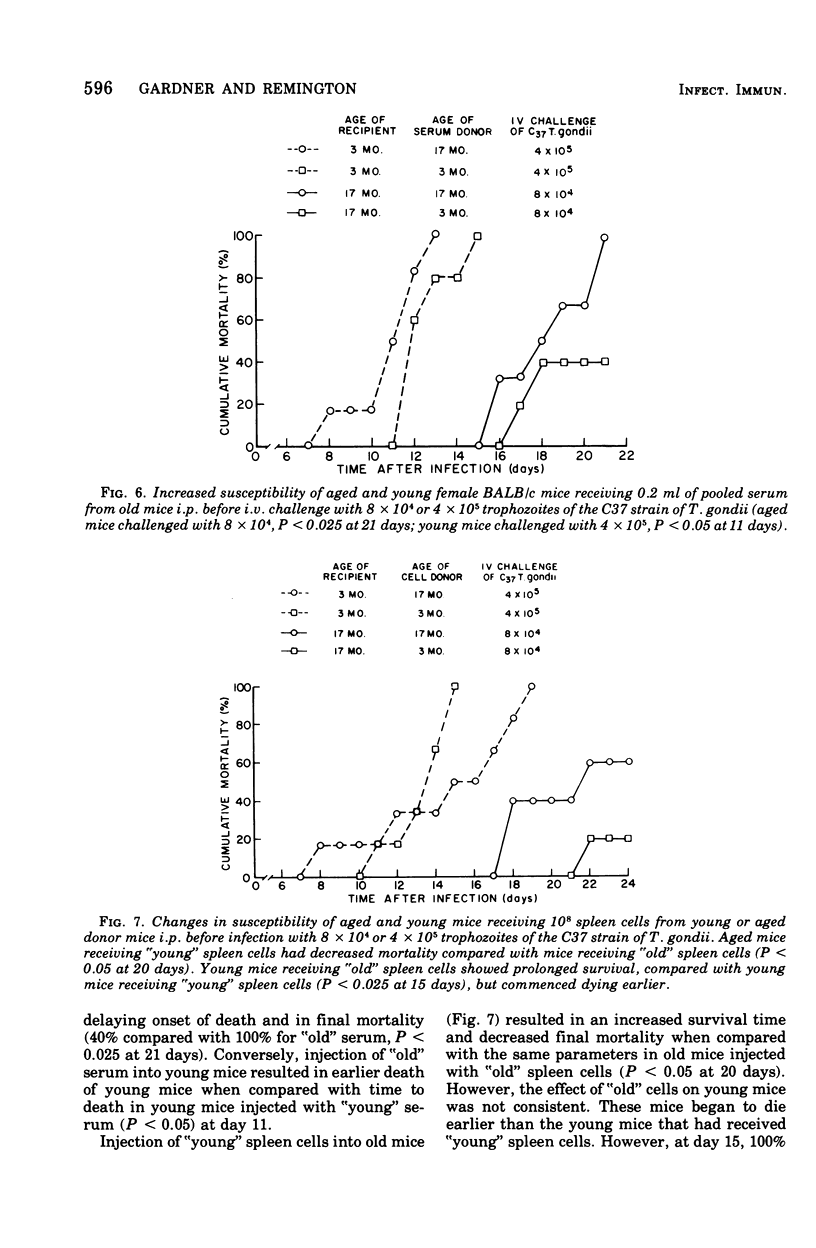
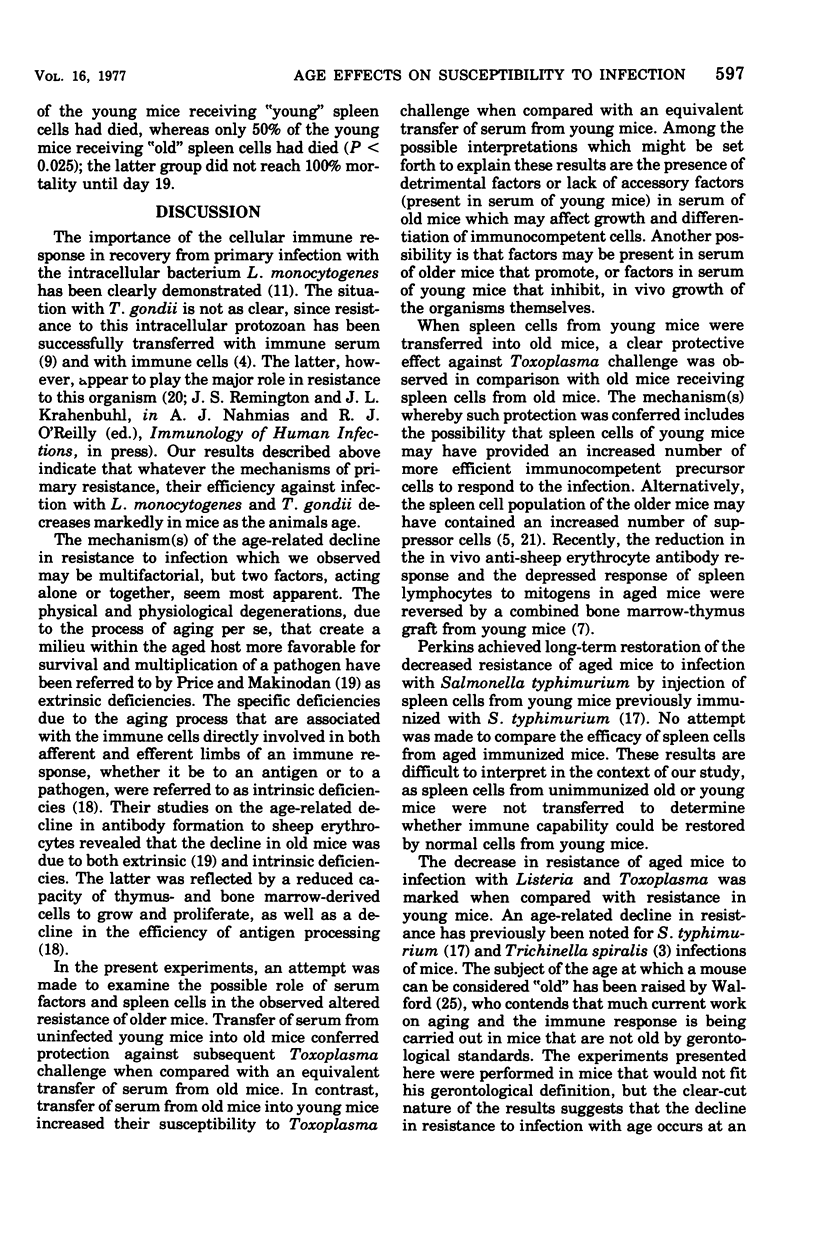
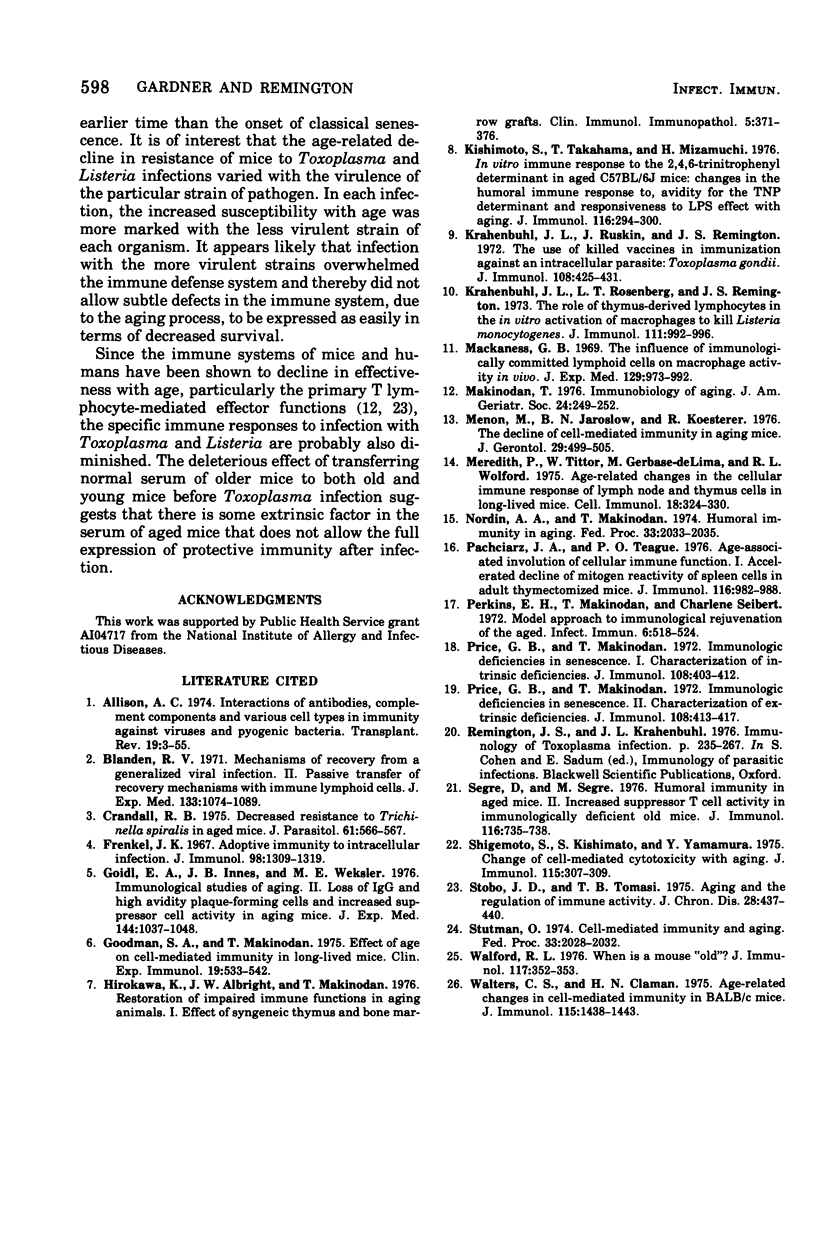
Selected References
These references are in PubMed. This may not be the complete list of references from this article.
- Allison A. C. Interactions of antibodies, complement components and various cell types in immunity against viruses and pyogenic bacteria. Transplant Rev. 1974;19(0):3–55. doi: 10.1111/j.1600-065x.1974.tb00127.x. [DOI] [PubMed] [Google Scholar]
- Blanden R. V. Mechanisms of recovery from a generalized viral infection: mousepox. II. Passive transfer of recovery mechanisms with immune lymphoid cells. J Exp Med. 1971 May 1;133(5):1074–1089. doi: 10.1084/jem.133.5.1074. [DOI] [PMC free article] [PubMed] [Google Scholar]
- Frenkel J. K. Adoptive immunity to intracellular infection. J Immunol. 1967 Jun;98(6):1309–1319. [PubMed] [Google Scholar]
- Goidl E. A., Innes J. B., Weksler M. E. Immunological studies of aging. II. Loss of IgG and high avidity plaque-forming cells and increased suppressor cell activity in aging mice. J Exp Med. 1976 Oct 1;144(4):1037–1048. doi: 10.1084/jem.144.4.1037. [DOI] [PMC free article] [PubMed] [Google Scholar]
- Goodman S. A., Makinodan T. Effect of age on cell-mediated immunity in long-lived mice. Clin Exp Immunol. 1975 Mar;19(3):533–542. [PMC free article] [PubMed] [Google Scholar]
- Hirokawa K., Albright J. W., Makinodan T. Restoration of impaired immune functions in aging animals. II. Effect of syngeneic thymus and bone marrow grafts. Clin Immunol Immunopathol. 1976 May;5(3):371–376. doi: 10.1016/0090-1229(76)90046-5. [DOI] [PubMed] [Google Scholar]
- Kishimoto S., Takahama T., Mizumachi H. In vitro immune response to the 2,4,6-trinitrophenyl determinant in aged C57BL/6J mice:changes in the humoral immune response to, avidity for the TNP determinant and responsiveness to LPS effect with aging. J Immunol. 1976 Feb;116(2):294–300. [PubMed] [Google Scholar]
- Krahenbuhl J. L., Rosenberg L. T., Remington J. S. The role of thymus-derived lymphocytes in the in vitro activation of macrophages to kill Listeria monocytogenes. J Immunol. 1973 Oct;111(4):992–995. [PubMed] [Google Scholar]
- Krahenbuhl J. L., Ruskin J., Remington J. S. The use of killed vaccines in immunization against an intracellular parasite: Toxoplasma gondii. J Immunol. 1972 Feb;108(2):425–431. [PubMed] [Google Scholar]
- Mackaness G. B. The influence of immunologically committed lymphoid cells on macrophage activity in vivo. J Exp Med. 1969 May 1;129(5):973–992. doi: 10.1084/jem.129.5.973. [DOI] [PMC free article] [PubMed] [Google Scholar]
- Makinodan T. Immunobiology of aging. J Am Geriatr Soc. 1976 Jun;24(6):249–252. doi: 10.1111/j.1532-5415.1976.tb03299.x. [DOI] [PubMed] [Google Scholar]
- Menon M., Jaroslow R. N., Koesterer R. The decline of cell-mediated immunity in aging mice. J Gerontol. 1974 Sep;29(5):499–505. doi: 10.1093/geronj/29.5.499. [DOI] [PubMed] [Google Scholar]
- Meredith P., Tittor W., DeLima M. G., Walford R. L. Age-related changes in the cellular immune response of lymph node and thymus cells in long-lived mice. Cell Immunol. 1975 Aug;18(2):324–330. doi: 10.1016/0008-8749(75)90060-x. [DOI] [PubMed] [Google Scholar]
- Nordin A. A., Makinodan T. Humoral immunity in aging. Fed Proc. 1974 Sep;33(9):2033–2035. [PubMed] [Google Scholar]
- Pachciarz J. A., Teague P. O. Age-associated involution of cellular immune function. I. Accelerated decline of mitogen reactivity of spleen cells in adult thymectomized mice. J Immunol. 1976 Apr;116(4):982–988. [PubMed] [Google Scholar]
- Perkins E. H., Makinodan T., Seibert C. Model approach to immunological rejuvenation of the aged. Infect Immun. 1972 Oct;6(4):518–524. doi: 10.1128/iai.6.4.518-524.1972. [DOI] [PMC free article] [PubMed] [Google Scholar]
- Price G. B., Makinodan T. Immunologic deficiencies in senescence. I. Characterization of intrinsic deficiencies. J Immunol. 1972 Feb;108(2):403–412. [PubMed] [Google Scholar]
- Price G. B., Makinodan T. Immunologic deficiencies in senescence. II. Characterization of extrinsic deficiencies. J Immunol. 1972 Feb;108(2):413–417. [PubMed] [Google Scholar]
- Segre D., Segre M. Humoral immunity in aged mice. II. Increased suppressor T cell activity in immunologically deficient old mice. J Immunol. 1976 Mar;116(3):735–738. [PubMed] [Google Scholar]
- Shigemoto S., Kishimoto S., Yamamura Y. Change of cell-mediated cytotoxicity with aging. J Immunol. 1975 Jul;115(1):307–309. [PubMed] [Google Scholar]
- Stobo J. D., Tomasi T. B. Editorial: Aging and the regulation of immune reactivity. J Chronic Dis. 1975 Oct;28(9):437–440. doi: 10.1016/0021-9681(75)90054-5. [DOI] [PubMed] [Google Scholar]
- Stutman O. Cell-mediated immunity and aging. Fed Proc. 1974 Sep;33(9):2028–2032. [PubMed] [Google Scholar]
- Walford R. L. Letter: When is a mouse "old"? J Immunol. 1976 Jul;117(1):352–352. [PubMed] [Google Scholar]
- Walters C. S., Claman H. N. Age-related changes in cell-mediated immunity in BALB/C mice. J Immunol. 1975 Nov;115(5):1438–1443. [PubMed] [Google Scholar]


